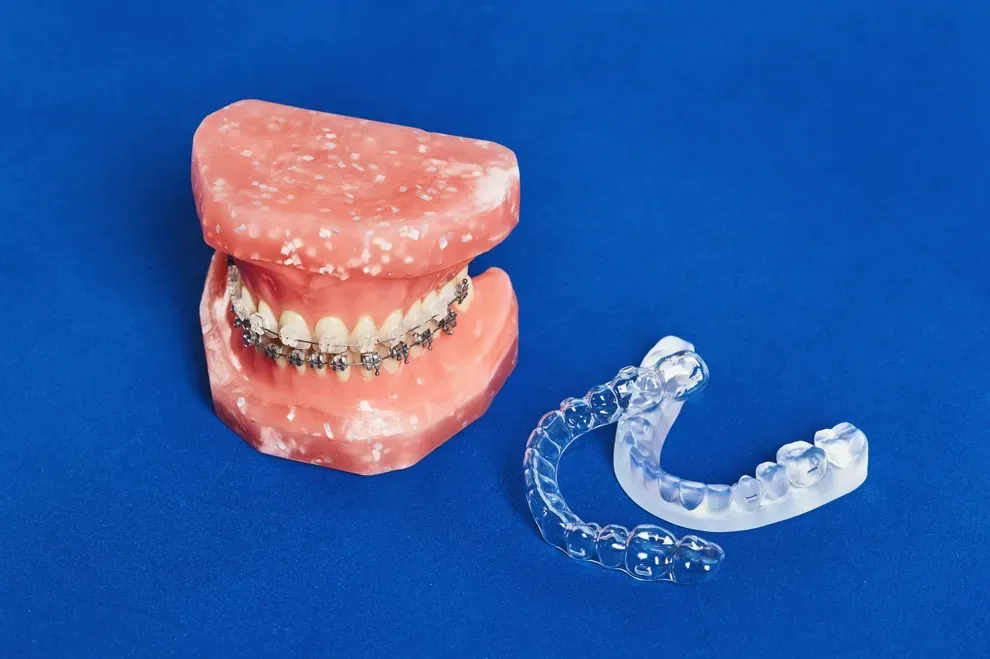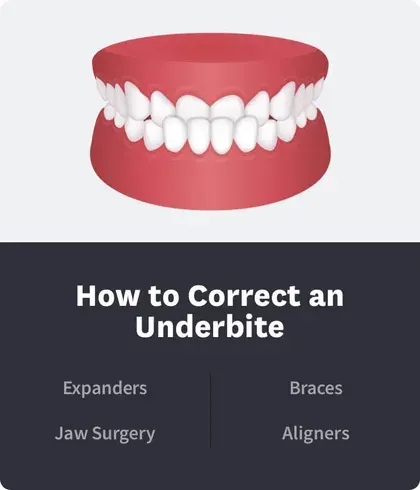How Underbite Correction Actually Works

Table of Contents
- Key Facts
- How to Correct an Underbite
- Common Misconceptions
- Consult a Professional
- References
An underbite is a form of malocclusion, or teeth misalignment, in which the lower teeth sit in front of the upper teeth. Underbite is also known as a Class 3 malocclusion, prognathism, or a reverse bite.
An underbite can be minor, with the lower teeth only slightly overlapping the top teeth, or severe, with the lower jaw visibly protruding in front of the upper mouth.
Treatments for underbite depend on the severity of the problem. Braces or clear aligners are used to correct misaligned teeth, sometimes with the help of orthodontic appliances like a palatal expander or reverse-pull face mask.
For major underbite, jaw surgery may be required. Tooth extraction may be needed if teeth are too crowded to allow space for teeth to shift into their correct positions.
Key Facts about Underbite Correction

An underbite is a form of teeth misalignment. With an underbite, the lower teeth protrude in front of the upper teeth.
Underbite can be mild or severe. Severe cases are often caused by jaw misalignment.
Many cases of underbite can be corrected with orthodontic treatment like braces or clear aligners.
The use of orthodontic devices like a palatal expander or reverse-pull face mask may also be used to correct an underbite, especially with children and teens whose jaws haven’t developed yet and are therefore more adaptable to treatment.
If an underbite is caused by a jaw condition, jaw surgery may be needed.
How to Correct an Underbite
Underbite correction options will vary depending on how serious the bite problem is, what’s causing it, and your age and jaw development.
Treatment of an underbite may include the following:
Regardless of how minor or severe your underbite is, treatment will require correcting the alignment of your teeth. This means teeth will have to be moved and shifted into new positions.
If your orthodontic issues include crowding, tooth extraction may be necessary to ensure there’s enough space for your teeth to move into new positions.
Orthodontic devices like reverse-pull face masks and palatal expanders are used to influence jaw development and growth, and correct jaw misalignment. While some devices may be used in adult treatment, they are more commonly used in children and adolescent orthodontics. This is because devices are more effective when used on jaws that are still developing, as opposed to mature adult jaws.
Reverse-pull face masks are similar in appearance to traditional orthodontic headgear. They wrap around the head and attach by bands to the teeth in order to apply pressure to encourage movement.
Palatal expanders may be attached to the roof of the mouth and expanded to widen the jaw.
Braces are probably the most well-known of treatment options for teeth misalignment, and they continue to be used to treat malocclusion, including underbite. Severe cases of underbite may require traditional metal braces treatment, sometimes with an extended treatment timeline and the use of additional orthodontic devices.
Braces move teeth by applying continuous gentle pressure through a bracket and archwire system. Small brackets are cemented onto the teeth. They are then connected by wires that run through the arches of the upper and lower teeth. These archwires are tightened during regular orthodontist visits to provide the pressure needed to move the teeth and bite into correction.
Although some severe cases of underbite may require traditional metal braces, there are other (less visible) types of braces available today as well. Ceramic braces are sometimes called invisible braces because they use tooth-colored or clear hardware. Lingual braces, while expensive, are virtually invisible as they are applied to the back of teeth.
For those with a mild or moderate underbite, clear aligners offer many advantages over braces for orthodontic treatment. In addition to being clear and not noticeable, aligners are removable, so they won’t get in the way of eating or your oral hygiene routine. Aligners also offer fast treatment times and don’t require uncomfortable adjustment appointments.
Aligners are clear trays that fit over the teeth but have subtle changes and pressure points to encourage tooth movement. At the beginning of your aligner treatment, an image of your current bite and teeth placement is captured using a tooth scan or impression kit. Then, software and/or specialists create an image of what your ideal smile and bite would look like — where your teeth would have optimal alignment.
Your aligner provider designs and produces a series of aligners that will gradually move your teeth into those corrected positions. You’ll wear each set of aligners for a week or two before moving on to the next.
Aligners are available through orthodontists and mail-order providers. With in-office aligners, the treatment is more traditional, with regular orthodontist visits.
Mail-order aligners offer a more modern approach to treatment. Byte, for example, offers a completely at-home, doctor-monitored treatment, with a mail-order impression kit, virtual check-ins, and access to an award-winning app to check on progress and access clinical and support staff.
If an underbite is caused by a jaw issue — including jaw placement, a jaw injury, or jaw misalignment — jaw (orthognathic) surgery may be needed as part of the orthodontic treatment. Braces or aligners will still be needed to address teeth misalignment.
Common Misconceptions about Underbite Treatment
Plenty of people have questions about how underbite correction works. Many more hold misconceptions about therapy that can keep them from getting the help they need. These are some common misconceptions:
You aren't required to choose between braces, aligners, and surgery. Some people use combinations of two solutions. Others use all three as they amend their teeth.
Each tool works in a different way and delivers different results. You may need the help of every tool we've mentioned. If you do, an orthodontist and oral surgeon will guide you through the process.
Braces always seem to come first in discussions of underbite correction. They are valuable solutions for some people, but they aren't the only option open to you.
Other options might work better to amend your smile. If you are looking for a more discrete, affordable, and faster treatment approach, aligners might be a good fit.
An underbite can be unsightly, and researchers say that people tend to experience an improved quality of life when therapy is over, and they look better.
But underbites also strain muscles and teeth. Sometimes, they make cleaning hard. It's reasonable to fix the issue to protect overall health.
Consult a Professional
Underbites are both common and treatable. People with the issue shouldn't let misinformation keep them from the help they need.
If you have a minor to moderate overbite, you might start with a consultation with an aligner company. This comes in the form of an impression kit you’ll use at home to take impressions of your teeth. A doctor will review these impressions and determine if their aligner product can correct your underbite.
If you aren’t a candidate for aligners, talk to an orthodontist about the best treatment path for you. Severe overbites may require a combination of approaches like surgery, braces, or aligners.
